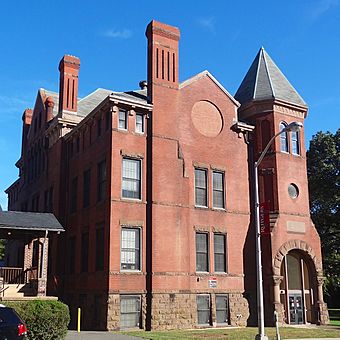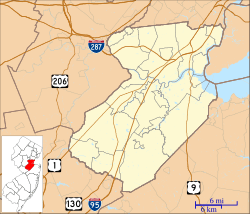New Jersey Hall facts for kids
|
New Jersey Hall
|
|
 |
|
| Location | 73 Hamilton Street New Brunswick, New Jersey |
|---|---|
| Area | 0.3 acres (0.12 ha) |
| Built | 1889 |
| Architect | George K. Parsell |
| Architectural style | Romanesque, Richardsonian Romanesque |
| NRHP reference No. | 75001144 |
Quick facts for kids Significant dates |
|
| Added to NRHP | February 24, 1975 |
New Jersey Hall is a historic building at Rutgers University in New Brunswick, New Jersey. It was built in 1889. This building was very important for science and learning in New Jersey.
It was added to the National Register of Historic Places on February 24, 1975. This means it is a special place recognized for its history in farming and education.
Contents
New Jersey Hall's History
New Jersey Hall was built in 1889. The architect who designed it was George K. Parsell. The land for the building was given to Rutgers by James Neilson Jr.
The money to build New Jersey Hall came from the Hatch Act of 1887. This law helped fund farming research programs. Before this, the Morrill Land Grant Act of 1862 helped colleges focus more on farming and mechanical arts.
Rutgers as a Land-Grant College
Rutgers became New Jersey's land-grant college. This opened up new chances for learning and growth. George Hammell Cook was a big supporter of Rutgers becoming this type of college.
He was also the first leader of the New Jersey Agricultural Experiment Station. This station was first located inside New Jersey Hall. The building also held the college's Chemistry and Biology departments.
Today, New Jersey Hall is mostly an office building. It houses the university's Department of Economics. It also holds the New Jersey Bureau of Economic Research.
Building Design and Style
New Jersey Hall was built by architect George K. Parsell in 1889. Its design mixes two styles: Queen Anne and Richardsonian Romanesque.
The outside of the building is made of cut stone. It has three main floors and a tall basement. There are two ways to enter the building. One entrance faces Voorhees Mall, and the other faces Hamilton Street.
Special Features
Both entrances have stone arches. These arches are supported by Romanesque columns with special tops called capitals. These details make the building look grand and historic.
In 1903, a fire damaged a large part of the roof and the third floor. But the damaged areas were rebuilt to look just like the original design. Since then, only small updates and fixes have been done. The building still looks very much like it did when it was first built.
Important Laws for Education
Two important laws helped shape New Jersey Hall and Rutgers University. These were the Morrill Act and the Hatch Act.
The Morrill Act of 1862
The Morrill Act of 1862 gave New Jersey land in the west. This land was sold, and the money helped New Jersey fund new departments. These departments focused on farming and mechanical arts.
Rutgers University was chosen to get these funds. It became New Jersey's land-grant college. This change helped higher education focus more on sciences. It also made it possible for more New Jersey residents to get a formal education. This included people who might not have been able to afford it before.
The Hatch Act of 1887
The Hatch Act of 1887 was also very important. It gave Rutgers an annual payment of $15,000 from the New Jersey government. This money helped create the New Jersey Agricultural Experiment Station.
On May 11, 1888, plans and money were approved to build New Jersey Hall. This building was needed to house the Experiment Station. It also provided new laboratories for students and researchers.
How New Jersey Hall Was Used for Learning
New Jersey Hall was home to the Chemistry and Biology departments at Rutgers. Students had more space to do research and experiments. They focused especially on farming and mechanical arts.
Scientific Discoveries
Important discoveries were made in New Jersey Hall. For example, scientists learned more about how to use fertilizers. They also made advances in using insecticides.
These experiments also allowed chemists to act like a food and drug safety group for New Jersey residents. They helped make sure food and medicines were safe for people to use.




